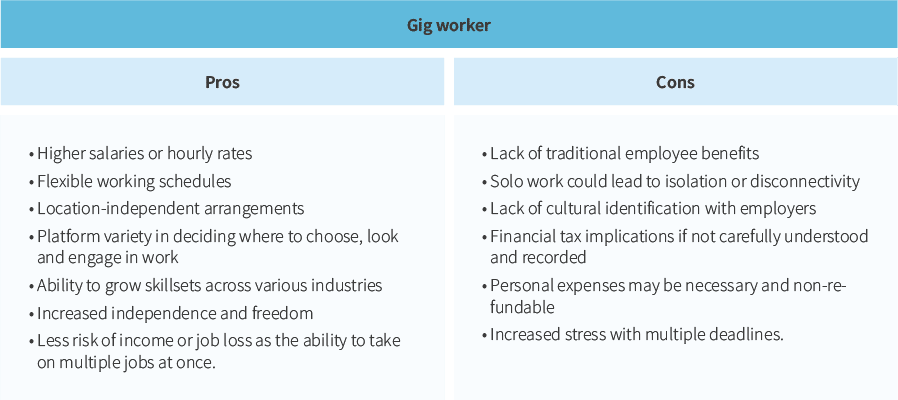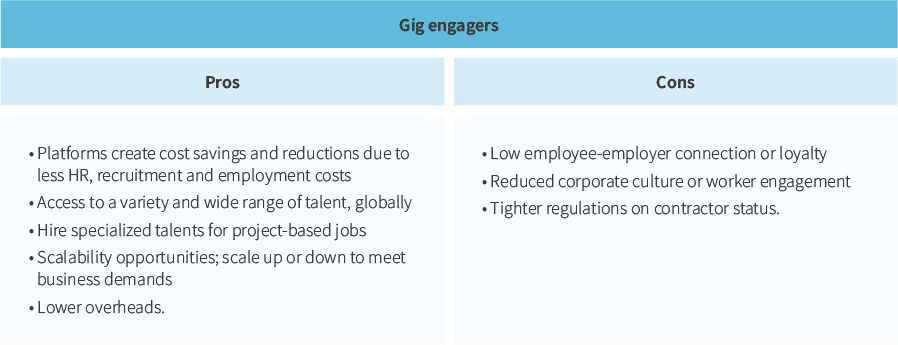The gig economy: a liquid workforce

If you are familiar with on-demand platforms such as Uber, Airbnb, Fiverr, Upwork, Didi or Lyft, you’ve been exposed to the gig economy. Whether you’re a consumer or contractor, you have been introduced to a global market that is expected to grow from U.S. $204 billion in 2018 to a staggering U.S. $455 billion in 2023. Growing at a compound annual growth rate of 17.4%, the gig economy has become unmissable in today’s work landscape.
In this blog, we will talk through what the gig economy is, showcase the impact of the gig economy on various markets and explain how your organization can thrive, support and benefit from investing in this fast-growing specialist market.
What is the gig economy?
If you haven’t heard the term gig economy, perhaps you are familiar with its other names such as ‘the shared economy’ or ‘the contingent economy’? Regardless of the name, the gig economy ‘represents a free market system in which organizations and independent workers engage in short-term work arrangements’.
Think of it as working agreements that operate more closely to a ‘gig’; like musicians that perform at a music venue for one night. It stems from the idea that the work has no guarantee of continuing past that one assignment or one short-term contract. It allows workers the flexibility to start and end working arrangements as necessary and move on to the next assignment without the hassle of intense contracts or interview processes.
This flexibility is thanks to recent digitization booms and the increased use and creation of online platforms that allow such ‘chopping and changing’ actions. While it may sound unstable and unreliable at first, there are procedures and policies in place to ensure the work gets done within the agreed time frame between ‘gig worker’ and ‘gig employer’.
Consider Uber or Uber Eats as an example. The gig worker can simply turn on the application and start getting notified of work as it becomes available. Once the gig worker accepts the job, they are liable for completing the work necessary. The application has policies and rules in place that ensures the gig is completed to a satisfactory standard. Once the job is done, the gig worker can opt to accept another one as it comes through or simply turn off the application and call it a day.
The basis of a ‘liquid workforce’ concept is the idea that these gig workers flow like water. They are able to come and go as they please from one business to the next. From an organization’s perspective, the liquid workforce stems from their ability to hire a variety of talent as they deem fit for specific jobs. For example, they may employ a freelance copywriter with 7+ years of experience in sports journaling for a research piece on the ins and outs of A-league baseball and then hire a freelance copywriter with several years of experience in brand marketing to create a new product campaign. The flexibility here allows for the copywriter to use their expertise to create highly accurate content that will look favorably upon the organization when it hits the market. That organization could hire both at the same time, or more, without the need to look into intense employment contracts or lengthy salary negotiations.
What classifies gig work?
So, what work is generally classified as working under the gig economy? This can be very dependent on your country's definition of gig work as it can be influential come tax time.
To make it easier, we have broken up this section to explain popular examples of gig platforms and gig jobs or employment opportunities.
.png?width=924&name=M_Web_Gig%20Platforms%20(1).png)
Popular gig economy jobs include:
- Graphic design and branding
- Digital marketing
- Freelance writing or copywriting
- Pet sitting and dog walking
- Virtual assistant
- Driving for on-demand transport services
- Web development and coding
- Delivering food
- Proofreading and editing
- Video editing
- Advanced or specialized jobs
- Selling or renting property.
The following graph shows the primary fields of freelancing as published by Payoneer in their 2020 Freelancer Income Report.
.png?width=707&name=M_Web_Primary%20field%20of%20freelancing%20(1).png)
Something to note: almost any job can be related to the gig economy if the arrangement is set to be predominantly short-term focused or project-based. Gig work can essentially be divided into two depending on the geographic requirements of the work performed: one is where you require your gig workers to be in a particular location or place and the other is gig work that can be done via the cloud or remotely.
The impact of the gig economy
McKinsey forecasts that by 2025, 540 million people will be seeking work through online talent platforms related to the gig economy; and of that, 230 million of them will be able to secure work on those platforms.
What do the facts say? What are the key statistics supporting the growth of the gig economy?
- The number of freelancers in the United States will hit 86 million by 2027
- The United Kingdom’s gig economy workforce has grown to 4.7 million, doubling in size from 2016
- Globally, the most popular gig work came down to design and technology-focused freelance jobs (59%)
- 44% of gig workers state freelancing as their primary source of income in the United States
- When it comes to employee job satisfaction, gig economy workers are more satisfied than when they were employed in traditional positions (79%)
- Almost two-thirds of gig workers believe their working conditions are flexible
- One of the most popular reasons people look for gig work is because it helps them achieve a better work-life balance (70%)
- 55% of gig workers also have full-time or traditional jobs
- 19% of gig works perform gig work to cover daily expenses or make extra cash on the side
- 64% of full-time millennials would be interested in taking up side hustles in the gig economy to make extra money
- 54% of gig workers don’t get access to employer-provided benefits.
The success of platforms like Uber and Airbnb has shown employees and employers around the world that the gig economy is a viable and very real market that fits the future of work arrangements. Organizations everywhere consider temporary and short-term contracts as an appropriate long-term strategy to keep up with market changes rather than retaining a predominantly full-time workforce.
What are the pros and cons of embracing the gig economy?
It’s important to consider two perspectives when considering pros and cons: the benefits for gig workers and the benefits for organizations or gig engagers.


How to thrive in the gig economy?
From an organization’s perspective, thriving in the gig economy involves:
- Staying up-to-date with regulations of contingent labor: make sure you or your HR functions are all across the necessary laws and regulations around hiring short-term, contingent employees. There are both federal, state and national laws that protect both gig workers, so it’s crucial to understand the limitations and entitlements of engaging in a liquid workforce before stepping foot onto a gig economy platform.
- Try and facilitate some form of corporate culture: to set your gig workers up for success, try and establish a standard and reusable onboarding process. For example, if you want your gig workers to work locally, give them the space to do so. If you want them remote, make sure you have shared access to all documents and folders they need to get the job done. Introduce them to the internal stakeholders they will be collaborating with. That way, if you need to engage them again, they’ll be more likely to say yes and also produce higher quality outputs.
From a gig worker's perspective, thriving in the gig economy involves:
- Keep stable routines and establish a dedicated space of work: whatever you need to implement into your daily routine to ensure the work gets done for your clients or employer at the time; set it up. If that means you have to create an online diary hour by hour or invest in a daily planner log to keep on top of tasks - do it. This way you can see all of your projects, categorized by the employer, and the deadlines so that you remain on top of things. A dedicated workplace, whether you work remotely or not, will offer the stability in keeping all these routines separate from your home life.
- Maintain a beneficial professional network: as you go about working for new and different clients, if your gig work allows it, make sure to keep in touch, connect on professional networks like LinkedIn and establish professional connections that may benefit you in the future. Who knows? You may get work for a company that requires you once a year, at the same time every year and there is your income settled for that period.
How to support and incorporate gig work into your business model?
Whether you are looking at the gig economy to incorporate into your current business model, today, thanks to the pandemic, keeping up with changes in the workplace is a must. In addition to an increase in the gig economy is a workplace revolution that is not going anywhere; hybrid working.
While the pandemic may have been the impetus for many executives to finally roll out work-from-home and remote work initiatives or invest in gig workers, the enthusiasm with which employees have embraced them means there is no turning back. While some managers cling to the hope that everyone will be back in the office soon, several studies would suggest that is wishful thinking.
A hybrid workplace model may be able to facilitate efficient collaboration between your permanent employees and your short-term, contingent ones. Learn more about implementing a healthy hybrid workplace.
Popular posts
Browse by topic
- Accounting
- Accounting & Finance
- All Industries
- Banking
- BPO/RPO/HRO
- Communication
- CSR & ESG
- Customer & Client Acquisition
- Customer Experience
- Cybersecurity
- Cybersecurity & Compliance
- Data Management
- Digital Operations
- Digital Transformation
- eCommerce
- Education
- Employee Engagement
- Engineering & Construction
- Financial Services
- Healthcare
- Hospitality and tourism
- HR & Recruitment
- Information Technology
- Insurance
- Legal Services
- Logistics
- Offshoring & Outsourcing
- Outsourcing
- Professional Services
- Real Estate
- Retail & eCommerce
- Startups
- Talent Acquisition and Retention
- Technology
- Trends & Guides
- Workforce Integration
Related Posts
How employers can reduce healthcare costs
A lot has been written about how the working world has changed in the wake of the COVID-19 pandemic. Where many managers once linked productivity..
AI customer support: benefits, challenges and best practices
The evolution of customer support has been a sight to behold. From the birth of postal systems that allowed businesses to engage with customers in a..
The future of customer service: why 24/7 support is non-negotiable
Imagine trying to resolve an issue with a product or service late at night, only to find the company's customer service is closed. Waiting hours for..
